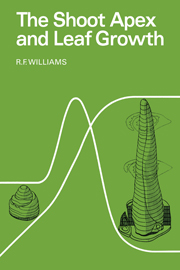6 - The growth of an inflorescence
Published online by Cambridge University Press: 04 August 2010
Summary
This short chapter is concerned solely with the growth and development of the ear of wheat, Triticum aestivum. At the outset it is freely admitted that the work was undertaken largely in response to the challenge of describing such a complex biological system with precision. There was also the hope that such work would throw light on the nature of the transition from vegetative to reproductive development in the wheat plant. The chapter draws heavily upon the descriptive paper by Williams (1966 a) and to a lesser extent on the more general statement on the inflorescence in Gramineae (Williams, 19666). Studies of the developmental morphology of the wheat spike have been made by Bonnett (1936) and Barnard (1955), and the latter's histogenetic classification of its members into foliar and cauline types is adopted.
The unit of the gramineous inflorescence is the spikelet, a group of one or more flowers – usually called florets – with a number of associated bracts. These are collected into inflorescences with a tremendous range of form, from the open panicle of Avena to very compact structures such as the spike in Triticum. A common form of the spikelet consists of an axis (the rachilla) bearing two sterile glumes at the base and an indefinite number of lemmas, each with a floret in its axil. In its mature state (at anthesis) the wheat spikelet is as depicted in Fig. 6.4E but its basic structure is more easily grasped at the developmental stage shown in Figs. 6.1 and 6.6. Fig. 6.1 shows two lateral spikelets in which the seventh (possibly the last) floret has just been initiated, and in which the glumes and other bracts have not yet grown up to conceal the inner members.
- Type
- Chapter
- Information
- Shoot Apex and Leaf Growth , pp. 183 - 198Publisher: Cambridge University PressPrint publication year: 1975

